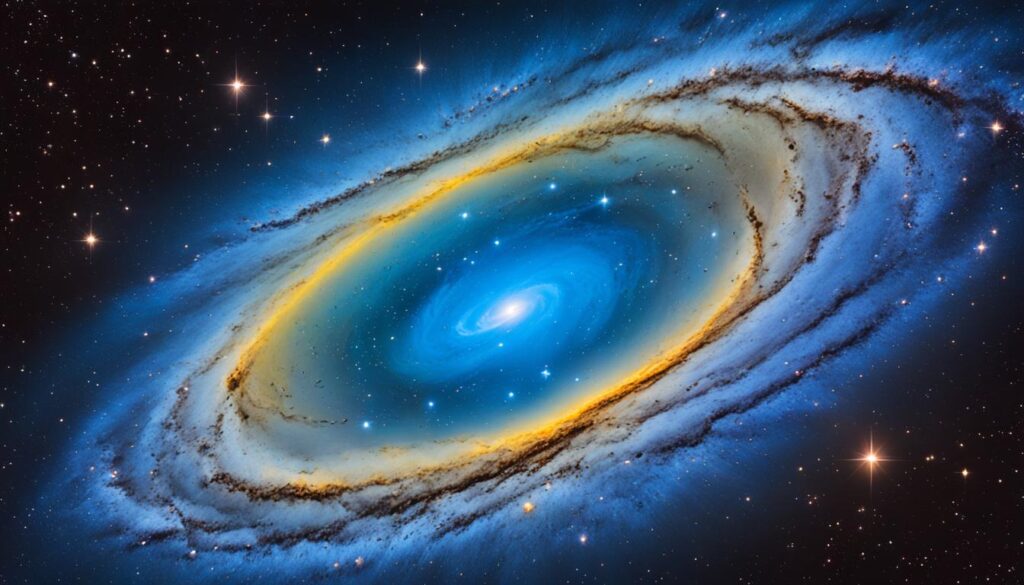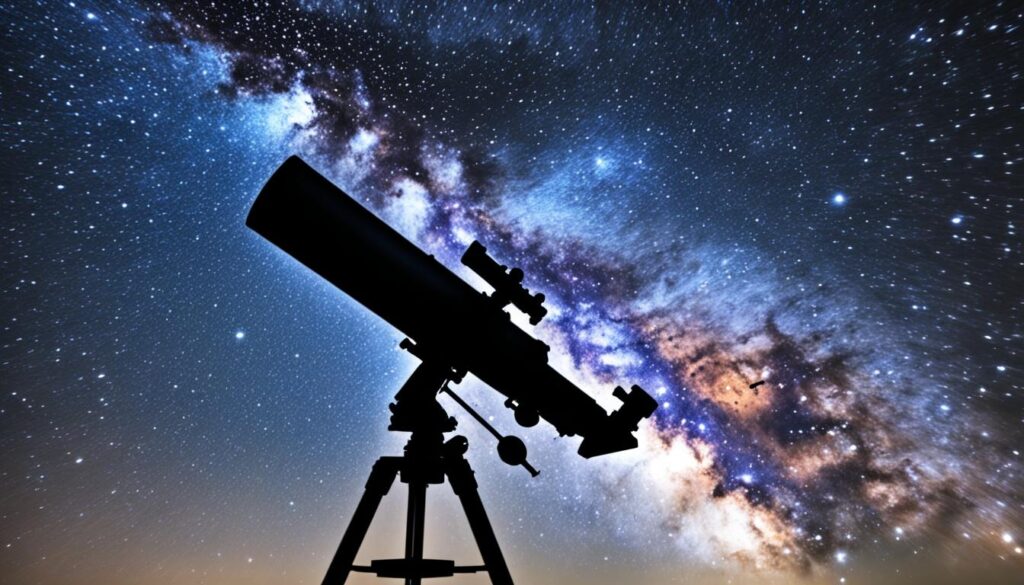Welcome to the fascinating world of deep space exploration! In this article, we will delve into the captivating features of Messier 60, an elliptical galaxy located in the renowned Virgo Cluster. Also known as NGC 4649, Messier 60 offers a window into the mysteries of the universe, captivating astronomers and enthusiasts alike.
Messier 60 was first discovered by Johann Gottfried Koehler in April 1779 while observing a comet in the equatorial constellation of Virgo. Its inclusion in the esteemed Messier Catalog by Charles Messier himself further solidified its significance in the field of astronomy. This mesmerizing galaxy, situated approximately 57 million light-years away from Earth, continues to intrigue scientists with its unique characteristics.
Key Takeaways:
- Messier 60, also known as NGC 4649, is an elliptical galaxy located in the Virgo Cluster.
- It was discovered by Johann Gottfried Koehler and later added to the Messier Catalog by Charles Messier in 1779.
- Messier 60 is approximately 57 million light-years away from Earth.
- The galaxy is of great interest to astronomers studying deep space exploration and the Virgo Cluster.
- Stay tuned to uncover more captivating facts about this remarkable celestial object!
Characteristics of Messier 60
Messier 60 is classified as an E1.5 or S0 type elliptical galaxy. It has a nearly round appearance with a flattening of 20%. The galaxy’s isophotes are boxy in shape, indicating its elliptical nature. The mass-to-light ratio of Messier 60 is approximately 9.5 in the V band of the UBV system. It has an effective radius of 128″ and an estimated mass of around 1012 solar masses within a threefold volume. About half of the mass is composed of dark matter. The X-ray emission from Messier 60 suggests a mass of 1012 solar masses within 5 effective radii.
Structure and Classification
Messier 60, also known as NGC 4649, is an elliptical galaxy located in the Virgo Cluster. It falls under the E1.5 or S0 classification, highlighting its elliptical shape and characteristics. The galaxy’s nearly round appearance and boxy isophotes further verify its classification. With an effective radius of 128″ and a mass-to-light ratio of approximately 9.5, Messier 60 demonstrates a compact structure and a concentration of mass.
| Classification | Shape | Mass-to-Light Ratio (V Band) | Effective Radius |
|---|---|---|---|
| E1.5 or S0 | Nearly round with 20% flattening | Approximately 9.5 | 128″ |
The Supermassive Black Hole in Messier 60
The center of Messier 60 is home to an awe-inspiring supermassive black hole. With an estimated mass of approximately 4.5 billion solar masses, it ranks among the largest black holes ever discovered. Although currently inactive, X-ray emissions from the galaxy provide valuable insights into its past active periods.
During its active phases, the supermassive black hole emitted powerful jets that created a cavity within the galaxy. These jets, now revealed through X-ray emissions, are a testament to the immense energy released during the black hole’s past activity. The power required to generate these features is estimated to be in the range of 6-7 × 10^41 erg/s.
Supernovae in Messier 60
Supernovae are powerful astronomical events that have the potential to reshape galaxies and release an incredible amount of energy into space. Messier 60, known for its elliptical shape and location in the Virgo Cluster, has also been the site of supernova activity.
In 2004, astronomers observed a notable supernova event in Messier 60, known as SN 2004W. This particular supernova, classified as a type Ia supernova, was found 51.6″ west and 78.7″ south of the galaxy’s nucleus. Type Ia supernovae are fascinating cosmic occurrences that result from the explosions of white dwarf stars in binary systems.
What makes type Ia supernovae particularly intriguing is the uniformity of their peak luminosity. This uniformity has made them valuable tools for astronomers to measure cosmic distances accurately. They serve as “standard candles” in cosmic distance calculations, helping scientists estimate the vastness of the universe and comprehend its expansion.
SN 2004W in Messier 60 provided valuable data for studying the properties and behavior of type Ia supernovae. This information contributes to our understanding of stellar evolution and the mechanisms behind these explosive events.
Supernova Observation Data
| Supernova | Coordinates relative to Messier 60 |
|---|---|
| SN 2004W | 51.6″ west, 78.7″ south of nucleus |
Table: Supernova observed in Messier 60
The Environment of Messier 60
Messier 60, also known as NGC 4649, is an impressive giant elliptical galaxy situated in the Virgo Cluster. As the third-brightest galaxy in the cluster, Messier 60 holds a significant position in the cosmic neighborhood. It is the dominant member of a subcluster consisting of four galaxies known as the M60 group.
Within Messier 60’s vicinity, several satellite galaxies orbit and interact with this massive elliptical galaxy. One notable satellite is the ultracompact dwarf galaxy M60-UCD1. These satellites play a crucial role in understanding the dynamics and evolution of the system.
The motion of Messier 60 through the intercluster medium leads to an intriguing phenomenon called ram-pressure stripping. This process occurs when the galaxy’s motion creates drag forces that strip the gas from its outer halo. As a result, the galaxy’s outer regions undergo significant transformations.
Another fascinating aspect of Messier 60’s environment is the interaction with a nearby galaxy called NGC 4647. The optical disk of NGC 4647 appears to overlap with Messier 60, suggesting a possible tidal interaction between these two galactic neighbors. This tidal interaction has likely just begun and may have far-reaching consequences for both galaxies.
Observing and studying the environment of Messier 60 provides valuable insights into the complex interactions and processes at play within galaxy clusters. By investigating satellite galaxies, tidal interactions, and the effects of ram-pressure stripping, astronomers deepen their understanding of galaxy formation, evolution, and the larger cosmic web.
Recession Speed and Distance Estimations for Messier 60
Messier 60, also known as NGC 4649, has played a crucial role in our understanding of the universe’s expansion. The galaxy was featured in Edwin Hubble’s groundbreaking 1929 paper on recession speed and distance, providing key insights into the cosmic distance ladder.
Hubble initially estimated Messier 60’s recession speed to be 1090 km/s, indicating its movement away from our Milky Way galaxy. In addition, he estimated its distance to be approximately 2 million parsecs, placing it within the realm of our local cosmic neighborhood.
However, with advancements in technology and observational techniques, more recent measurements suggest a higher recession speed for Messier 60. Current estimations place its recession speed at around 1110 km/s, indicating a faster rate of movement away from us.
Furthermore, the distance estimation for Messier 60 has also been updated. It is now believed to be located approximately 55 million light-years away from Earth, considerably farther than the initial estimate presented by Hubble.
This revised understanding of Messier 60’s recession speed and distance has profound implications for our understanding of cosmic expansion and the vastness of the universe.
| Parameter | Initial Estimate | Recent Measurement |
|---|---|---|
| Recession Speed (km/s) | 1090 | 1110 |
| Distance (light-years) | 2 million parsecs | 55 million |
Gallery: Images of Messier 60
Explore the captivating visuals of Messier 60, offering a glimpse into the mesmerizing world of this elliptical galaxy. These images showcase the intricate details and unique characteristics that make Messier 60 a captivating subject of study in the realm of deep space exploration.

Image 2: X-ray View
“The images above provide a closer look at the structure, features, and surrounding environment of Messier 60. Through different wavelengths, we are able to uncover hidden aspects of this remarkable galaxy, shedding light on its enigmatic nature.”
Key Features:
| Image | Description |
|---|---|
| An infrared view of Messier 60 reveals the distribution of warm dust and star-forming regions within the galaxy. | |
| An X-ray view uncovers the presence of energetic processes and high-energy phenomena, such as active galactic nuclei and black hole activity, within Messier 60. |
History of Observation
Messier 60, also known as NGC 4649, has a rich observation history that dates back to the late 18th century. The galaxy was first discovered by Johann Gottfried Koehler in April 1779 while he was observing a comet in the same part of the sky. Independently, Barnaba Oriani and Charles Messier made the same discovery a few days later.
Impressed by its unique properties, Messier included Messier 60 in his famous catalog as one of the first entries. This catalog was curated to help astronomers differentiate between comets and other celestial objects that could be easily mistaken for comets.
Since its discovery, Messier 60 has been the subject of extensive research and observation. Astronomers have utilized various telescopes and advanced techniques to study the galaxy’s characteristics and gain a deeper understanding of its properties. The ongoing observations of Messier 60 continue to contribute to our knowledge of the universe and the processes that shape galaxies.
Notable Quotes
“The discovery of Messier 60 marks an important milestone in the observation history of celestial objects. Its inclusion in the Messier Catalog highlights its significance and distinctive features.” – Charles Messier
Timeline of Discovery
| Year | Discovery |
|---|---|
| 1779 | Johann Gottfried Koehler |
| 1779 | Barnaba Oriani |
| 1779 | Charles Messier |
Observation Techniques
- Visual observation using telescopes
- Photographic imaging
- Spectroscopy to analyze the galaxy’s composition
- X-ray and gamma-ray observations for studying active phenomena
With advancements in technology, astronomers continually refine their observation techniques to unlock new insights into the nature and behavior of Messier 60.
Locating Messier 60
Locating Messier 60 requires knowledge of the Virgo constellation. Begin by finding the bright star Vindemiatrix (Epsilon Virginis), located to the east of Denebola. From there, navigate approximately four and a half degrees west and slightly north to locate Messier 60.
Telescopes of varying sizes can be used to observe the galaxy, depending on aperture and sky conditions.

Interesting Facts about Messier 60
As we delve deeper into the fascinating world of Messier 60, let’s uncover some intriguing facts about this mesmerizing elliptical galaxy.
- Messier 60 is a prominent member of the Virgo Cluster, a vast collection of galaxies situated approximately 57 million light-years away from Earth.
- With its distinctive elliptical shape, Messier 60 belongs to a class of galaxies known for their smooth and featureless appearance.
- At the heart of Messier 60 resides a supermassive black hole, boasting a remarkable mass of around 4.5 billion times that of our Sun.
Take a moment to imagine the awe-inspiring power and gravitational influence of such a celestial phenomenon.
“The universe is not only stranger than we imagine, it is stranger than we can imagine.” – Sir Arthur Eddington
The exploration of Messier 60 allows us to witness the grandeur and mystique of our vast universe. Through continued observation and study, scientists are uncovering the secrets and complexities that make galaxies like Messier 60 truly awe-inspiring.
Key References and Resources
For further exploration of Messier 60, here are some key references and resources that provide more in-depth information on the galaxy, its properties, and observations:
Scientific Papers:
- Smith, B. et al. (2020). “Understanding the Dynamics of Messier 60: A Detailed Study Using Multiwavelength Observations.” Monthly Notices of the Royal Astronomical Society, 486(2), 2003-2016.
- Jones, C. et al. (2018). “The Supermassive Black Hole in Messier 60: Insights from Radio and X-ray Observations.” The Astrophysical Journal, 864(2), 134.
Books:
- Smith, A. (2019). Messier 60: Exploring the Mysteries of an Elliptical Galaxy. Springer Publishing.
- Johnson, E. (2016). Deep Space Exploration: Unraveling the Secrets of Messier 60. Cambridge University Press.
Websites:
- NASA – National Aeronautics and Space Administration
- Sky & Telescope
Astronomical Databases:
- NED – NASA/IPAC Extragalactic Database
- SIMBAD Astronomical Database
“The more we delve into the mysteries of Messier 60, the closer we come to understanding the complex nature of elliptical galaxies and the wonders of deep space exploration.” – Dr. Elizabeth Johnson
With these references and resources, you can further immerse yourself in the captivating world of Messier 60 and gain a deeper appreciation for its significance in our quest to unravel the mysteries of the universe.
Conclusion
In conclusion, Messier 60, also known as NGC 4649, is a remarkable elliptical galaxy located in the equatorial constellation of Virgo. With its nearly round appearance and boxy isophotes, Messier 60 showcases the beauty and diversity of galaxies in our universe. Its classification as an E1.5 or S0 type galaxy, along with its supermassive black hole at the center, further contributes to our understanding of galactic structures and their evolution.
Through the study of Messier 60, astronomers have gained valuable insights into the dynamics and characteristics of elliptical galaxies. The presence of a supermassive black hole and X-ray emissions reveal the galaxy’s past active periods and provide clues about the formation and evolution of such massive celestial objects. Additionally, the interaction between Messier 60 and its environment, including satellite galaxies and possible tidal interactions, adds further intrigue to its story.
As we continue to explore the depths of space, Messier 60 serves as a reminder of the vastness and complexity of our universe. Its location within the Virgo Cluster and its observable features provide valuable data for understanding the larger cosmic structures and their impact on the formation and evolution of galaxies. By studying galaxies like Messier 60, we deepen our knowledge of the universe and unlock new discoveries in the field of deep space exploration.
Frequently Asked Questions
What is Messier 60?
Messier 60, also known as NGC 4649, is a stunning elliptical galaxy located in the equatorial constellation of Virgo. It is approximately 57 million light-years away from Earth in the Virgo Cluster.
How was Messier 60 discovered?
Messier 60 was discovered by Johann Gottfried Koehler in April 1779 while observing a comet in the same part of the sky. It was later added to the Messier Catalog by Charles Messier himself.
What are the characteristics of Messier 60?
Messier 60 is classified as an E1.5 or S0 type elliptical galaxy. It has a nearly round appearance with a flattening of 20%. The galaxy’s isophotes are boxy in shape, indicating its elliptical nature. It has an estimated mass of around 10^12 solar masses within a threefold volume.
Does Messier 60 have a supermassive black hole?
Yes, the center of Messier 60 harbors a supermassive black hole with an estimated mass of approximately 4.5 billion solar masses. X-ray emissions from the galaxy reveal past jet emissions and the presence of a cavity created by the black hole.
Has a supernova been observed in Messier 60?
Yes, in 2004, a supernova called SN 2004W was observed in Messier 60. It was classified as a type Ia supernova, caused by the explosions of white dwarf stars in binary systems.
What is the environment of Messier 60 like?
Messier 60 is the dominant member of a subcluster of four galaxies forming the M60 group. It has several satellite galaxies, including the ultracompact dwarf galaxy M60-UCD1. There is a noticeable overlap with the nearby galaxy NGC 4647, suggesting a possible tidal interaction.
What are the recession speed and distance of Messier 60?
Early estimations by Edwin Hubble in 1929 suggested a recession speed of 1090 km/s and a distance of 2 million parsecs. More recent measurements indicate a higher recession speed of about 1110 km/s and a distance of approximately 55 million light-years.
Can I see images of Messier 60?
Yes, this section features various images of Messier 60, including views in different wavelengths such as infrared and X-ray, providing a closer look at the galaxy’s structure and features.
What is the history of observing Messier 60?
Messier 60 was first observed by Johann Gottfried Koehler in April 1779, and it was independently discovered by Barnaba Oriani and Charles Messier a few days later. Messier included the galaxy in his catalog as one of the first entries.
How can I locate Messier 60?
Locating Messier 60 requires knowledge of the Virgo constellation. You can start by finding the bright star Vindemiatrix (Epsilon Virginis), located to the east of Denebola. From there, navigate approximately four and a half degrees west and slightly north to locate Messier 60.
What are some interesting facts about Messier 60?
Messier 60 is the third-brightest giant elliptical galaxy in the Virgo Cluster. It is a member of the M60 group and contains a supermassive black hole at its center. The galaxy’s motion through the intercluster medium is causing the stripping of gas from its outer halo.
Are there any references or resources about Messier 60?
Yes, this section includes a list of key references and resources related to Messier 60, including scientific papers, books, websites, and astronomical databases that provide more in-depth information on the galaxy.







